There’s a reason “terminal” fonts are a standard for traditional roguelikes even today. Certainly tradition plays a part, but even more importantly, they’re designed to be highly readable.
Last year while still in pre-alpha Cogmind received a huge influx of font bitmaps to support different resolutions, in some cases with multiple variants at a given size. At that point the goal was to make sure Cogmind had a unique look that was also consistent regardless of resolution (or as close as possible given the difficulty of pixel-perfect scaling that maintains proportionality).
With the alpha launch behind us and hundreds of players diving into the game and providing feedback, the first few releases were/are aimed at quality of life enhancements--tweaking the interface and adding optional features that will improve the experience for even a minority of players (because the options menu is not already crowded enough =p).
By far the top request is to improve readability. A majority of players enjoy and prefer the Cogmind’s original font, but a number of factors contribute to poor readability for some players:
- The UI is extremely dense, and at minimum must be able to display an 80×60 grid of characters, thus screen resolution places an upper limit on the size of each character.
- Modern high-DPI monitors squeeze the grid cells into an even smaller physical space, making the native fonts hard to make out since in many cases they rely on lines with a pixel width of only one.
- For the same reason, Cogmind’s native fonts don’t usually stream or record very well--video compression tends to reduce single-pixel lines to almost nothing.
We can resolve these issues for most players by providing thicker fonts with more even pixel distribution, as well as multiple options at each size to suit slight differences in personal preference. These alternate fonts will lack the thematic appeal that we get with Cogmind’s sci-fi font, but accommodating players is more important--readability trumps all in a text-heavy game. Besides, they’re optional :)
With single words and short phrases readability is less of an issue. The biggest problems arise when reading log text, hacking results, and dialogue where there are full sentences and paragraphs to parse, so that’s the best test of readability and what I show below.
Four New Typefaces
Typeface #1: X11
This font comes from a common Linux windowing system. You can find a huge collection of bitmaps and even the source code for producing them here. Of the new fonts, X11 might be the easiest to read overall as it’s the most traditional of the bunch.
Typeface#2: Terminus
For Cogmind, I like Terminus for its natural readability with a shape that still preserves some sci-fi flavor. See many more sizes and optional features of this typeface here.
Typeface #3 / 4: Proggy / Dina
These fonts will be familiar to many programmers, as they’re commonly used for coding. Programming fonts are a natural place to look for good roguelike fonts, since they’re both monospaced and designed to facilitate character recognition.
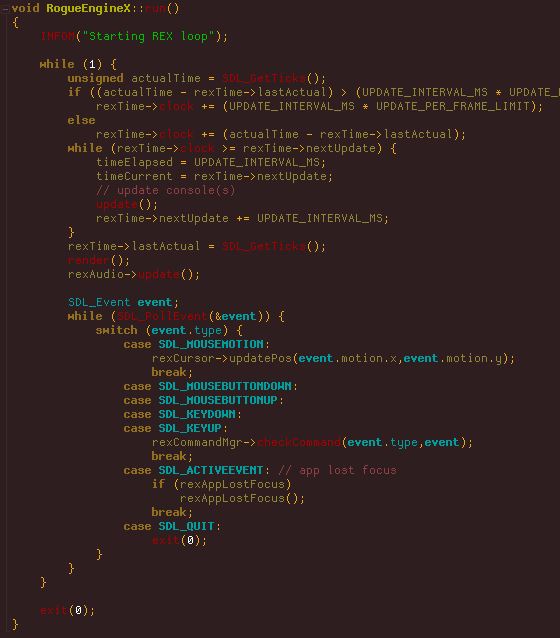
Cogmind’s entire engine loop as seen in the IDE (VS2010). I’ve been using Dina as my coding font for about eight years.
Adding these to the game was simply to provide some extra options at smaller resolutions, which they work best at. You can see the full selection of Proggy/Dina fonts here (all by the same author).
Options Menu
As of Alpha 2, Cogmind comes with a mind-boggling 82 font bitmaps.
For comparative images showing all the new fonts grouped by size, see this forum post. (There are also many larger sizes available for resolutions at and above 2K, though all are derived from fonts shown above.)
More Possibilities
The above fonts seem to have solved the readability issue for most players, at least those for whom their resolution-limited size is not simply too small regardless of font (and therefore requiring a larger screen to select greater sizes).
More typefaces can easily be added, though I think the current set combined with what was already there is enough to cover most needs. (The new fonts come with Alpha 2, to be released soon, though they were pre-released separately weeks ago in the forum post linked above.)
For those of you developing your own roguelikes, another nice option to consider is an amazing customizable font named Input.
This is the fourth in a four-part series on roguelike fonts:
- Part 1: Fonts in Roguelikes
- Part 2: Font Creation
- Part 3: Cogmind Fonts
- Part 4: Readable Text Fonts for Roguelikes
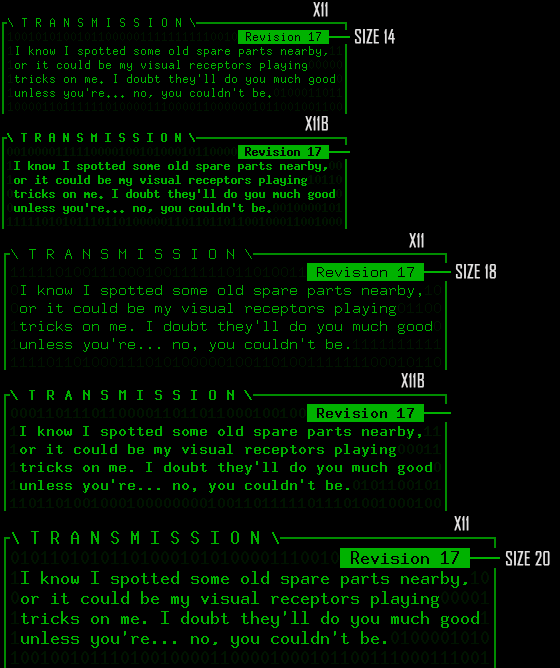
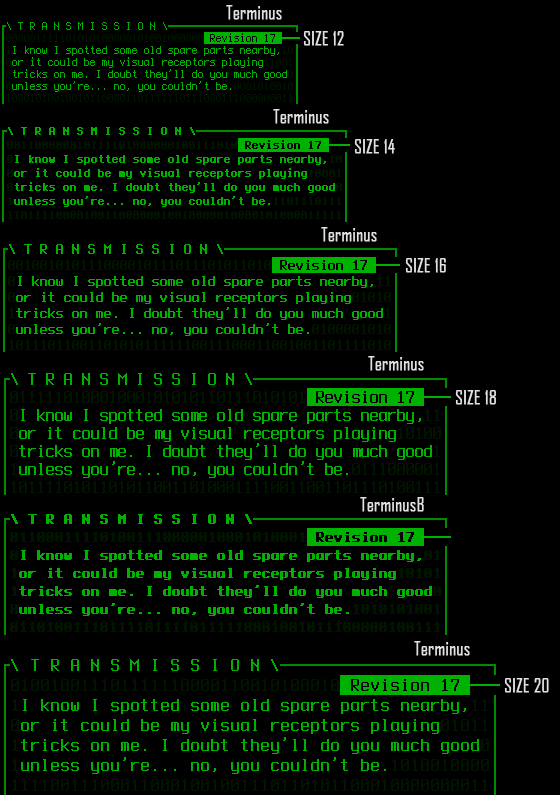
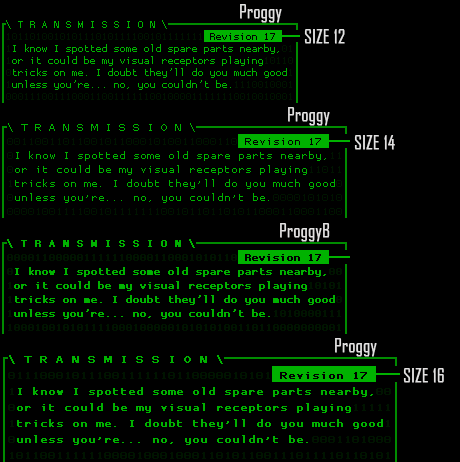
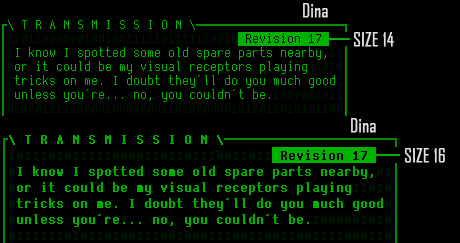
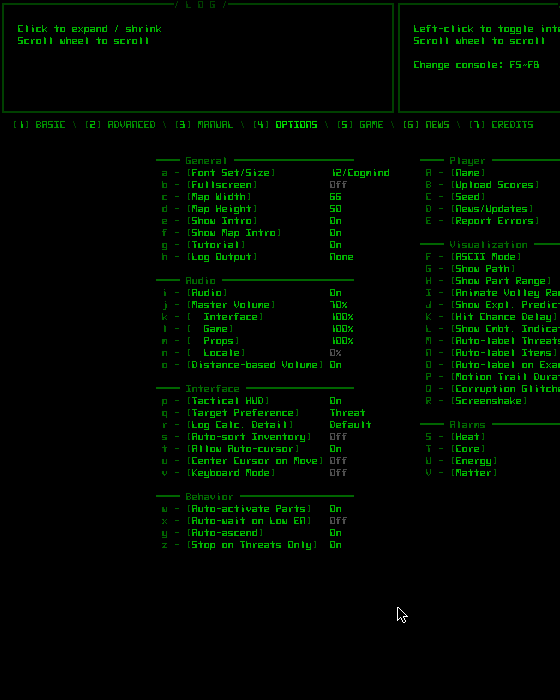


8 Comments
Interesting (as always, I suppose :P). As a thought, when you’re scaling up your Cogmind fonts, are you ever tempted to re-craft them, to make the most of the extra pixels in smoothing out some curved edges or the like?
With my own fonts, I do redesign them rather than simply rescale. I talked a bit about this in this old post. I don’t, however, use any dithering/shading--full saturation only--which makes it more difficult to get the same feel across certain different sizes. This is the drawback of going for a UI with a sharp look that is also scalable :/
Very nice set of articles :) DroidSansMono is my choice for my roguelikes in the last few years. A big big issue for me is choosing a font with a nice @ sign. Many fonts are really nice but have ugly @s, and I could not abide that!
Ah yes, another coding font and good suggestion!
I should’ve mentioned that in my case I always go for the perfectly crisp non-dithered look. DroidSansMono is a dithered font, though I really should explore some fonts from that category for their potential to solve readability issues under certain circumstances (like playing on a TV) or for certain players. I may not like how they ruin the aesthetic in this case, but then I already caved to the importance of usability by providing non-sci-fi fonts =p
I think the ‘@’ symbol in this font looks pretty cool. Sure it loses some of its @-ness, but has a charm of its own and is still recognizable for what it is.
And graphics! You caved by providing graphics! :P
It’s true I did for quite a while entertain the possibility of a purely ASCII game, since it stands so well on its own in that mode (being built for it…). I was honestly curious what the wider reception would be like, but it would’ve been a very costly experiment because of the many many lost sales from those who simply can’t do ASCII :/
Certainly I could (and will) open it up to player-made tilesets, but I might as well have the official one under my control. Plus I’m really happy with what Kacper’s done for Cogmind on that front :D
Yeah, I thought I’d be using ASCII a lot, but it turns out I just run the tileset exclusively. It’s good enough that I frequently have an idea of what I’m looking at before I actually check its stats for the first time -- and that’s a truly major achievement in design language.
For all ASCII’s benefits, you can’t translate the symbols just by looking at ’em.
But even the ASCII is labeled on seeing each one the first time! (I know you’re aware--linking for other/newer readers’ benefit.)
It’s true there is the non-hostiles exception, though they are so common and the majority appear near the beginning that they’re quickly learned regardless of mode. But hey, you can go to the pixel side if you want; they’re nice pixels =p